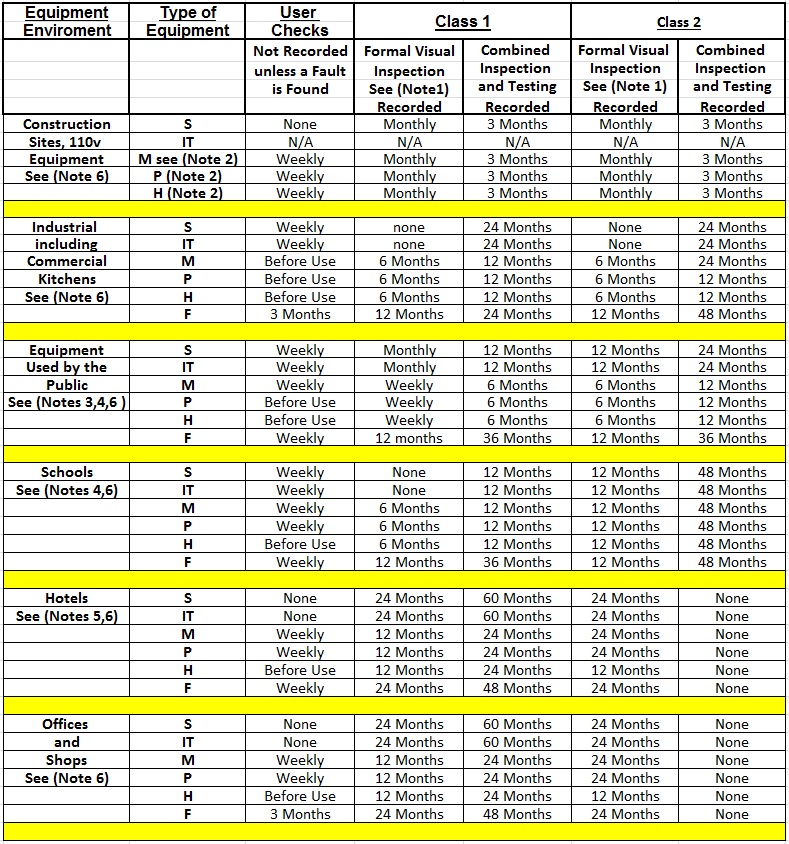It is a requirement in law that all businesses comply with the following legislation
Health and Safety at work Act 1974 (HSWA).
Electricity at Work Regulations 1989 (EAWR).
Management of Health and Safety at Work Regulations 1999 amended 2003 (MHSWR).
Provision and Use of Work Equipment Regulations 1998 amended 2002 (PUWER).
The recognised and recommended method to comply with this is PAT Testing
IET PAT Testing Guidelines
This Information is an Extract from the IET Code of Practice for the Inspection and Testing of Electrical Equipment (Edition 4) Sections 7.1 - 7.4 Pages 49 - 53
Page 49 Sub Section 7.1 Inspection.
In-service inspection and testing of equipment is essential to ensure safety and a regime of risk based assessments for inspections can often be carried out by the
user of the equipment and, in some circumstances, this may be all that is necessary. An example of circumstances where user checks may be the only inspection
required is in a low risk environment where Class 2 equipment is used.
Inspection should always precede testing if test is required.
A properly carried out inspection can identify many faults that will not necessarily be apparent from electrical tests, such as a cracked case, a loose connection,
a damaged flex and evidence of overheating.
Page 49 Sub Section 7.1.1 Risk-based assessments
Any risk-based assessments are the responsibility of the duty holder, eg, facility manager, building manager, landlord etc.
A duty holder may enlist the services of a competent person to assist in this process.
A risk assessment is defined as :
a systematic process of evaluating the potential risks that may be involved in a projected activity or undertaking, considering what could go wrong and deciding
on a suitable control measures to prevent loss, damage or injury in the work place. An assessment should include any controls required to reduce, minimize or
eliminate any risk.
More Concisely, if we assess anything for risk, we are assessing what level of harm or injury may result from a particular item of equipment. The level of risk
depends on factors that could have an adverse effect on us, or bystanders, while we are carrying out a task or using an item of equipment.
For the purpose of this code of practice we are concerned with the risk , or potential risk, for damage to an appliance or piece of equipment that could in turn
cause harm or injury to its user or bystander. Factors that can affect the level of risk we assessing are numerous and some of these are given in section 7.3.
There are many different methods of risk assessment and provided they are carried out within their individual scope of use, any can be used. It is important to
remember that their risk assessments should be reviewed regularly to ensure that any control measures are effective and that there are no changes in the
assessment factors. If there are any significant changes, the risk assessment should be updated to reflect this fact. Further information on risk assessments can be
found
in the Health and Safety Executive 9HSE) Publication (Five Steps to Risk Assessment), or as a free download from its website (www.hse.gov.uk).
The IET publication (Electrical Maintenance) second edition, also contains extensive information on how to conduct a detailed risk assessment.
Page 50 Sub Section 7.2 Categories of Inspection and Testing
Three categories of in-service inspection and testing are referred to in the code of practice.
1. User Checks.
Faults to be reported and logged and faulty equipment should be removed from service.
No record is required if no fault is found.
2. Formal visual Inspections.
Inspections without tests, the results of which, satisfactory or unsatisfactory, are recorded.
3. Combined Inspection and Tests.
The Results of which are recorded.
Page 50 / 51 Sub Section 7.3 Frequency of Inspection and Testing through Risk Assessments.
The relevant provision of the Electricity at Work Regulations 1989 is regulation 4(2), which states.
As may be necessary to prevent danger all systems shall be maintained so as to prevent, so far as is reasonably practicable, such danger.
Inspection and testing are means of determining whether maintenance is required. Frequency of inspection and testing will depend upon the likelihood of
maintenance being required and the consequence of lack of maintenance. To reflect accurately the legal requirements of electricity at Work regulation 4(2),
a robust risk assessment should be carried out in all cases, to evaluate the frequencies between inspection and testing. Risk encompasses many factors that can
eventually influence a final decision and should include the following :
1. The Environment :
Equipment installed in a benign environment, such as an office, will suffer less damage that equipment in an arduous environment, such as a construction site.
2. The Users :
If the users of equipment report damage as and when it becomes evident, hazards will be avoided. Conversely, if equipment is likely to receive unreported
abuse, more frequent inspection and testing is required.
3. The Equipment Construction :
The safety of a class 1 appliance is dependent upon a connection with the earth of the Fixed Electrical Installation. If the flexible cable is damaged the
connection with the earth can be lost.
The Safety of a Class 2 equipment is not dependent upon the integrity of the Electrical Installation. If equipment is known Class 2 and is used in a low risk
environment, such as an office, recorded testing (but not inspection ) may be omitted - see Table 7.1
4. The Equipment Type :
An appliance that is hand-held is more likely to be damaged than a fixed appliance. If such an appliance is also class 1 the risk of danger is increased,
because safety is dependent upon continuity of the protective conductor from the plug to the appliance.
5. the Frequency of Use :
Frequency of use of an appliance is important, particularly where portable, movable and hand held appliances are concerned,
because this may have implications on service life and exposure to possible damage.
6. The Type of Installation Methods :
Installation methods should be taken into account especially when assessing fixed equipment because the isolator position and cable management can be an
important factor when assessing risk.
7. Previous Records :
Where available , previous records of inspection, testing and maintenance should be used to evaluate the frequency of subsequent inspection and testing,
because they will provide a history of the environment and the users and how all this information affects the condition of the appliances within the environment.
All of the factors used in the risk assessment should culminate in an informed decision as to frequency of inspections and tests required. Table 7.1 provides only
some guidance on the initial frequencies of inspection and testing. It is not an absolute legal requirement and should not be considered as such. The future
frequencies of inspection and testing should depend on ongoing risk based assessments, dependent upon the factors above, i.e. any circumstance that may
affect the continuing safe condition of the equipment,
intervals between inspections and tests should be closely monitored and frequencies should be increased, decreased or kept the same, as appropriate.
It is the duty holder's responsibility to decide whether to vary or not, as the case may be, the inspection and test frequencies; in doing so he or she may wish
to take advice from the person doing the testing, HSE document HSG107 provides further guidance on frequencies of inspection and test.
The frequency of any recurring damage should be noted and corrective action taken.
Corrective action should to be considered should include :
Replacement of the equipment with a more rugged type
Training for the people using the equipment and
Increasing the frequency of Inspection and testing.
The most important check that can be carried out on a piece of equipment is the visual inspection, which identify many defects.
In the case of portable appliances or hand held tools these defects can occur in the plug, the cable or the casing.
If the user cannot routinely disconnect the equipment to facilitate a user inspection, this should be taken into account when
determining the frequency of recorded inspection.
Where premises have mixed use, the most appropriate frequency of inspection and testing will need to be adopted for each location or use.
Page 52 Table 7.1 Guidance on the initial frequency of Inspection and Testing of Equipment

Page 53 Notes to Table 7.1
1. The Formal visual Inspection may form part of the combined inspection and testing when they coincide, and is to be recorded
2. 110v Earthed centre tapped supply, 230v portable or hand held equipment is required to be supplied via a 30 mA RCD and inspections and tests may
need to be carried out more frequently (eg, a check of a portable RCD via its manual test button)
3. For some equipment such as children’s rides or equipment in more onerous environments a daily check may be necessary.
4. By Supervisor / Teacher / Member of Staff
5. Equipment provided in Hotel Rooms is equipment used by the public. Equipment in Hotels (Row 5 in the table) is considered to be used by the hotel staff.
6. Hired equipment in use for periods in excess of 1 week, should be included on an equipment register and a risk assessment carried out to determine the
future frequency of inspection and testing, unless the equipment is covered by a supplier's lease and maintenance contract, providing the maintenance
contract is robust and satisfactory.
It is normally not necessary to test new items of equipment as the manufacturer has already tested them.
Battery operated equipment less than 40 volts requires no visual or in service inspection and testing.
Note that specific guidelines for battery drills etc., used in mines, are not within the scope this code of practice
The Information on suggested initial frequencies given in table 7.1 is more detailed and specific than Hse guidance, but is not considered to be inconsistent
with it.
S. Stationary Equipment
IT. Information and Technology Equipment
M. Movable Equipment
P. Portable Equipment
H. Hand Held Equipment
F. Fixed Equipment
Page 53 7.4 Review of Frequency of Inspection and testing
Intervals between User Checks, Formal Visual Inspections and Combines Tests should be kept under review, particularly until patterns of failure or damage,
if any, are determined
Particular close attention should be paid to User Checks, Formal Visual Inspections and Combined Tests to see if there is a need to reduce the intervals or
change the equipment or its use.
After the first few inspections and tests consideration should be given to increasing the intervals or reducing them.
Table 7.1 provides only some guidance on the initial frequencies of inspection and testing.
It is not an absolute legal requirement and should not be considered as such.
The future frequencies of inspection and testing should depend on ongoing risk based assessments.





